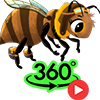Kamnik-Savinja Alps
Vobenca Waterfall
 virtual excursion
virtual excursion
Hidden in the off-road, it creates a right tributary of the Kokra, Vobenca (also Lobinca) almost unexpectedly beautiful, more than 20 m high waterfall. The stream is known to the locals as Vobenca, it is also marked Vobenca on older thematic topographic maps, but users of new editions of topographic maps that cite data from the National Topographic Map may be confused because the stream is marked as Lobnica...
The starting point towards the Vobence waterfall is from Zgornja Kokra, along the forest road (past house no. 64, Kokra), which leads up the stream. After 1200 m, the forest road (attention to private property) turns in a sharp bend to the south...
After 550 m of walking along the ravine (360 m as the crow flies), the gorge closes and we find ourselves in front of a 20 m high waterfall, which in the lower part of the 9 m high waterfall falls into a shallow pool...
The top of the entire waterfall turns into a narrow gutter eroded into reddish rock. The water flows into a gutter from a floating pool – a hollow into which about 10 m high streams of stream flow. One would not really expect traces of civilization here. But a surprise – a little above the top of the waterfall rises up to 2.5 m high stone wall...
* Note: the description of access to the waterfall is from 1993, when I intensively researched the possibilities of waterfalls: a cabinet by crossing the DMR and a layer of watercourses on a computer and then a field check after a "successful hit" – and this time the waterfall was "discovered" Vobenca.